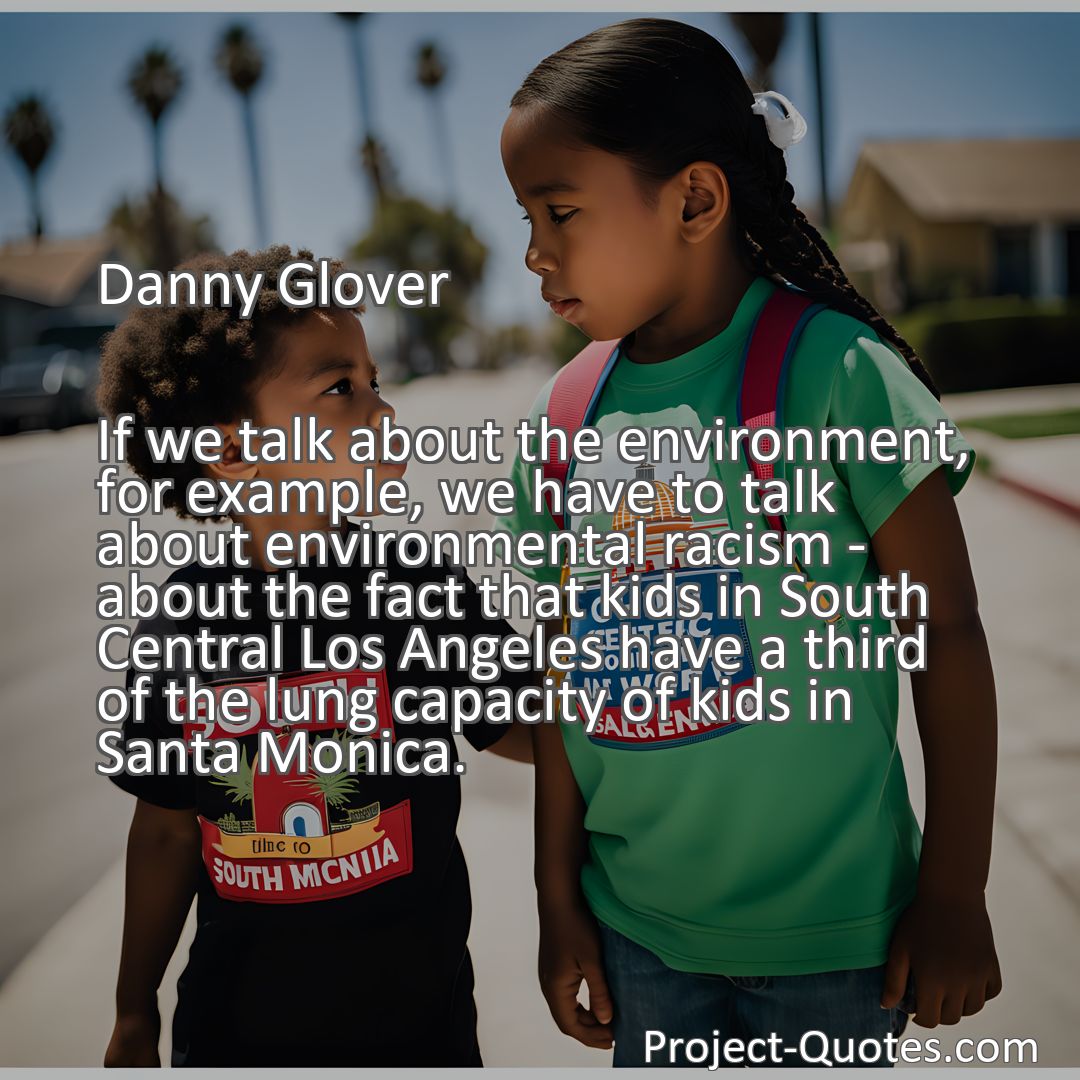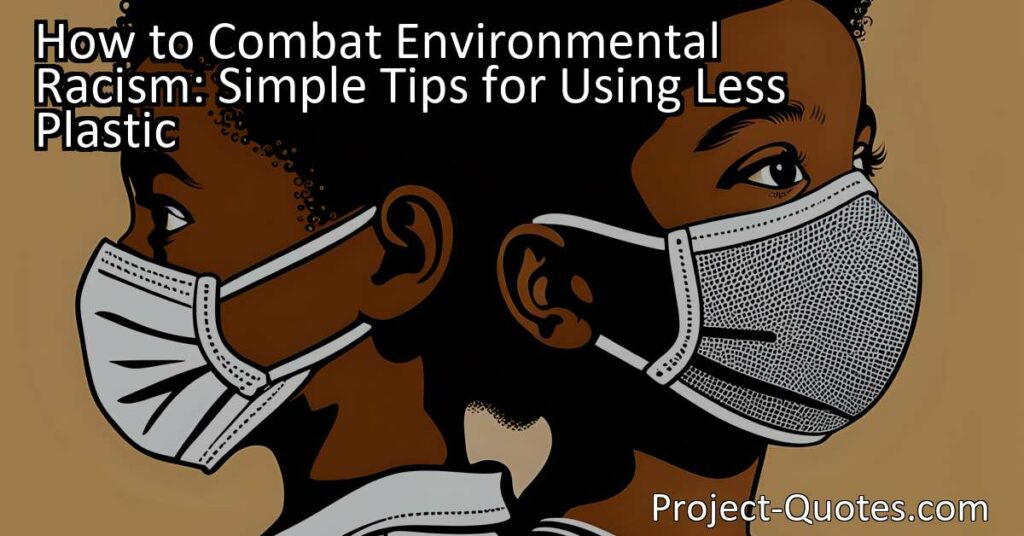If we talk about the environment, for example, we have to talk about environmental racism – about the fact that kids in South Central Los Angeles have a third of the lung capacity of kids in Santa Monica.
Danny Glover
In the fight against environmental racism, one simple thing we can all do is use less plastic. By making small changes like using reusable bags, bottles, and straws, we can help reduce pollution and create a healthier environment for all. Let’s take care of our planet and combat environmental racism together!
Table of Contents
- 1 If we talk about the environment, for example, we have to talk about environmental racism – about the fact that kids in South Central Los Angeles have a third of the lung capacity of kids in Santa Monica.
- 2 Danny Glover
- 3 Meaning of Quote – If we talk about the environment, for example, we have to talk about environmental racism – about the fact that kids in South Central Los Angeles have a third of the lung capacity of kids in Santa Monica.
- 4 Freely Shareable Quote Image
- 5 Related
Meaning of Quote – If we talk about the environment, for example, we have to talk about environmental racism – about the fact that kids in South Central Los Angeles have a third of the lung capacity of kids in Santa Monica.
The wise words of Danny Glover, a talented actor and passionate activist, touch upon a very important and eye-opening topic: environmental racism. When he speaks about kids in South Central Los Angeles having only a third of the lung capacity of kids in Santa Monica, he sheds light on a troubling issue. It’s a reminder that where you live can have a huge impact on your health, and unfortunately, not all places and all people are treated the same when it comes to the environment.
So, what exactly is environmental racism? It’s a term that might sound complicated at first, but it’s actually pretty straightforward. It means that some communities, especially those where people of color or folks with less money live, often face more environmental hazards. This could mean they’re living closer to polluting factories, dealing with poor water quality, or breathing dirtier air. And this isn’t by accident; it’s a pattern that happens all over the world.
In the case of children in South Central Los Angeles, living with less lung capacity means they can’t breathe as easily or as well as other kids not too far away in Santa Monica. Chicago, New York, and other big cities show similar patterns. Generally, the air in South Central LA is filled with more pollutants from cars, factories, and other sources. This means kids growing up there might have more asthma attacks, miss school due to breathing problems, and face other health challenges simply because of where they live.
Environmental racism is like a mean bully that doesn’t play fair, picking on certain communities and making their environment unhealthy. These communities often struggle to get the attention and help they need to clean up their environment. They might not have the money or resources to fight back against big polluters or to move to a cleaner area. It’s a tough situation, and it’s definitely not fair.
Now, let’s look at the other side of the street, or rather, the other side of town – Santa Monica. It’s a city with lovely beaches, parks, and generally, much cleaner air. Kids there can play outside without worrying as much about breathing in something nasty. They have better chances of not getting sick from their environment, which seems only fair, right? Everyone should have the chance to grow up healthy and strong, no matter where they live.
But environmental racism doesn’t only affect people’s health; it also has to do with nature, plants, animals, water, and air – the environment itself. Think about a park. Parks are places to relax, play soccer, have picnics, and take deep breaths. But did you know that some neighborhoods don’t have as many parks or green spaces? And factories that produce a lot of pollution, instead of being spread out, are often found clustered near the neighborhoods of minority or lower-income people.
Imagine two neighborhoods: one with lots of trees, parks, and open spaces, and the other with few trees and more factories and highways. The neighborhood with more greenery will likely have better air quality because trees help clean the air. They’re like nature’s superheroes, fighting off pollutants and giving us fresh oxygen to breathe. So, it’s not just about having a nice place to play tag or read under a tree – it’s also about having a healthy place to live.
It might seem like a huge problem without a solution, but there’s good news. People are working to fix things, and there are many ways we can all help.
Firstly, we can learn and talk about it. Think about a classroom where everyone raises their hand to participate – everyone’s voice is important. When we talk about environmental racism, we’re raising our hands and saying, “This is not right, and we want to change it.” By speaking up, we can inform others who might not know about the issue. Knowledge is like a seed, and once planted, it can grow into big, positive changes.
Secondly, communities can come together to plant trees, create gardens, and clean up trash. These are small steps, but just like doing your homework bit by bit, it adds up to a big difference in the end. Getting involved in community projects helps make the neighborhood healthier and stronger.
Thirdly, there are organizations you can support or join that work to make sure everyone, no matter the color of their skin or the amount of money they have, gets a fair chance at a healthy environment. These groups might talk to politicians, write letters to companies, or hold events to teach people how to protect their environment.
Lastly, each of us can do our part by being mindful of our own impact on the environment. Simple things like using less plastic, recycling, saving water, and turning off lights when you don’t need them all contribute to a healthier planet.
Danny Glover’s powerful words remind us of a world where every child, every person deserves to breathe clean air, drink clean water, and enjoy life’s simple outdoor pleasures. Let’s be the kind of friends to our environment that we’d want for ourselves – caring, protective, and fair. After all, when we make the world a fairer and healthier place, we’re not only helping others; we’re making a better home for everyone, including ourselves.
I hope this quote inspired image brings you hope and peace. Share it with someone who needs it today!


